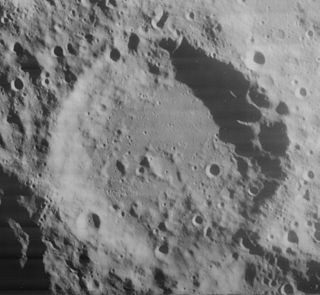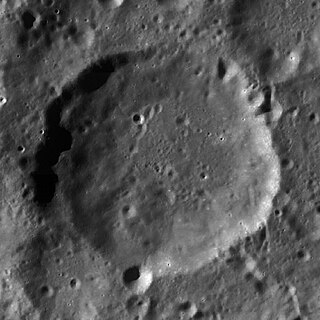
Bruce is a small lunar impact crater located in the small lunar mare Sinus Medii. It lies to the west-northwest of the irregular crater Rhaeticus, and is about 33 km to the west of the even smaller Blagg. It is named for Catherine Wolfe Bruce, an American philanthropist and patroness of astronomy.

Barnard is a lunar impact crater that is located near the eastern limb of the Moon. It is attached to the southeast rim of the large crater Humboldt, and Abel lies directly to the south. To the northeast is the crater Curie, while to the southeast is the Mare Australe.

Blanchinus is a lunar impact crater that is situated in the rugged south-central highlands of the Moon. The crater is named after Italian astronomer Giovanni Bianchini whose Latinized name is Blanchinus. Adjacent to the south of Blanchinus is the crater Werner, and La Caille is attached to the northwest rim. West of the crater is the prominent formation Purbach.

Bose is a lunar impact crater that is located on the far side of the Moon, in the southern sphere hemisphere. It lies just to the northwest of the smaller crater Bhabha, and southeast of Alder.

Doerfel is a lunar impact crater that is located in the vicinity of the southern pole, just on the far side of the Moon. It lies approximately midway between the large crater Hausen to the east-northeast and the even larger Zeeman to the southwest.

Chamberlin is a lunar impact crater that is located on the far side of the Moon, just past the southeastern limb. It lies to the southeast of the crater Jeans, and Moulton is attached to the southeastern rim of Chamberlin. This crater is located in a part of the lunar surface that has undergone resurfacing of crater interiors, producing dark-hued crater floors.

Brianchon is a lunar impact crater that is located along the northwestern limb of the Moon. Due to its location, from the Earth the crater is seen from the edge and its visibility is somewhat affected by libration. Thus for a more detailed view, the crater must be viewed from orbit.

Fabry is a large lunar impact crater of the form termed a walled plain. It is located on the far side of the Moon, just beyond the northeastern limb. Parts of this area are sometimes brought into view by the effects of libration, but the terrain is seen from the edge and so not much in the way of detail can be observed.

Berosus is a lunar impact crater that is located in the northeast part of the Moon, less than one crater diameter northwest of Hahn. Further to the east-northeast is the large crater Gauss, and to the north-northwest lies Bernoulli. Because of its location, this crater appears foreshortened when viewed from the Earth.

Ukert is a lunar impact crater that lies on a strip of rugged ground between Mare Vaporum to the north and Sinus Medii in the south. It was named after German historian Friedrich August Ukert. It is located to the north-northwest of the crater Triesnecker and northeast of the crater pair of Pallas and Murchison.

Playfair is a lunar impact crater that is located in the rugged southern highlands on the near side of the Moon. It was named after the Scottish geologist and mathematician John Playfair. It lies along the eastern rim of the eroded satellite crater Playfair G, a formation that is almost twice the diameter of Playfair itself. Playfair is nearly due north of the crater Apianus, and to the southwest of the Abenezra–Azophi crater pair.

Helmholtz is a lunar impact crater, approximately 110 kilometers in diameter, that is located near the south-southeast limb of the Moon. Attached to the south-southeast rim of Helmholtz is the somewhat smaller crater Neumayer. The larger crater Boussingault is nearly attached to the west-southwestern rim.

Clark is a lunar impact crater that lies in the southern hemisphere of the Moon's far side. It is located midway between the larger walled plain Van der Waals to the south and the similar-sized crater Pizzetti to the north. It is named for American astronomer and telescope maker Alvan Clark and his son Alvan Graham Clark.

Fraunhofer is a lunar impact crater that is located just to the south-southwest of the walled plain Furnerius, in the southeastern part of the Moon. This crater appears foreshortened when viewed from the Earth, and is actually nearly circular.

Donner is a lunar impact crater on the far side of the Moon. It is located just to the northeast of the Mare Australe, behind the southeastern limb of the Moon. During favorable librations this part of the lunar surface can be brought into view of the Earth, but the site is viewed from the edge and so not much detail can be seen.
Eijkman is a lunar impact crater that is located on the far side of the Moon's southern hemisphere. It lies about a half crater diameter to the southeast of the larger crater Lemaître. To the south-southwest is the crater Crommelin, and to the northeast is Fizeau.

Poynting is a large lunar impact crater located on the far side of the Moon. It is located to the north-northwest of the walled plain Hertzsprung, with the crater Fersman immediately to the east and Kekulé equally near to the west-southwest.

Roche is a large crater on the far side of the Moon from the Earth. The prominent crater Pauli lies across the southern rim of Roche, and the outer rampart of Pauli covers a portion of Roche's interior floor. To the north-northwest of Roche is the crater Eötvös, and just to the west-northwest lies Rosseland.

Levi-Civita is a lunar impact crater formation that lies on the far side of the Moon. It was named after Italian mathematician Tullio Levi-Civita. It is located just to the southwest of the large walled plain Gagarin, and nearly as close to the crater Pavlov to the south-southwest. To the northwest of Levi-Civita lies the smaller crater Pirquet.

Von der Pahlen is an eroded lunar impact crater that lies on the far side of the Moon from the Earth. It is located about one crater diameter to the south-southwest of the crater Strömgren. Farther to the south is the larger Chebyshev, and to the west-southwest lies Das.




















